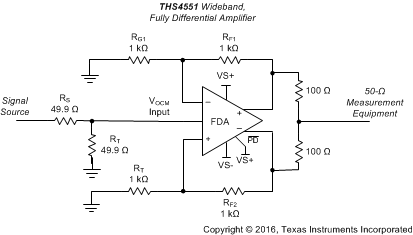JAJSL64D April 2016 – June 2021 THS4551
PRODUCTION DATA
- 1 特長
- 2 アプリケーション
- 3 概要
- 4 Revision History
- 5 Companion Devices
- 6 Pin Configuration and Functions
-
7 Specifications
- 7.1 Absolute Maximum Ratings
- 7.2 ESD Ratings
- 7.3 Recommended Operating Conditions
- 7.4 Thermal Information
- 7.5 Electrical Characteristics: (VS+) – (VS–) = 5 V
- 7.6 Electrical Characteristics: (VS+) – (VS–) = 3 V
- 7.7 Typical Characteristics: (VS+) – (VS–) = 5 V
- 7.8 Typical Characteristics: (VS+) – (VS–) = 3 V
- 7.9 Typical Characteristics: 3-V to 5-V Supply Range
-
8 Parameter Measurement Information
- 8.1 Example Characterization Circuits
- 8.2 Output Interface Circuit for DC-Coupled Differential Testing
- 8.3 Output Common-Mode Measurements
- 8.4 Differential Amplifier Noise Measurements
- 8.5 Balanced Split-Supply Versus Single-Supply Characterization
- 8.6 Simulated Characterization Curves
- 8.7 Terminology and Application Assumptions
- 9 Detailed Description
- 10Application and Implementation
- 11Power Supply Recommendations
- 12Layout
- 13Device and Documentation Support
- 14Mechanical, Packaging, and Orderable Information
パッケージ・オプション
メカニカル・データ(パッケージ|ピン)
サーマルパッド・メカニカル・データ
発注情報
8.3 Output Common-Mode Measurements
The circuit of Figure 8-5 is a typical setup for common-mode measurements.
 Figure 8-5 Output Common-Mode
Measurements
Figure 8-5 Output Common-Mode
MeasurementsIn Figure 8-5, the differential path is simply terminated back to ground on the two 1-kΩ input resistors and the VOCM control input is driven from a 50-Ω matched source for the frequency response and step response curves of Figure 7-43 and Figure 7-44. The outputs are summed to a center point (to obtain the average, or common-mode, output) through two 100-Ω resistors. These 100-Ω resistors form an equivalent 50-Ω source to the common-mode output for measurements. This common-mode test circuit is available as a TINA-TI™ simulation file. Figure 7-45 illustrates the common-mode output noise measurements with either a ground on the VOCM input pin or with the VOCM input pin floating. The higher noise in Figure 7-45 for a floated input can be reduced by including a capacitor to ground at the VOCM control input pin.